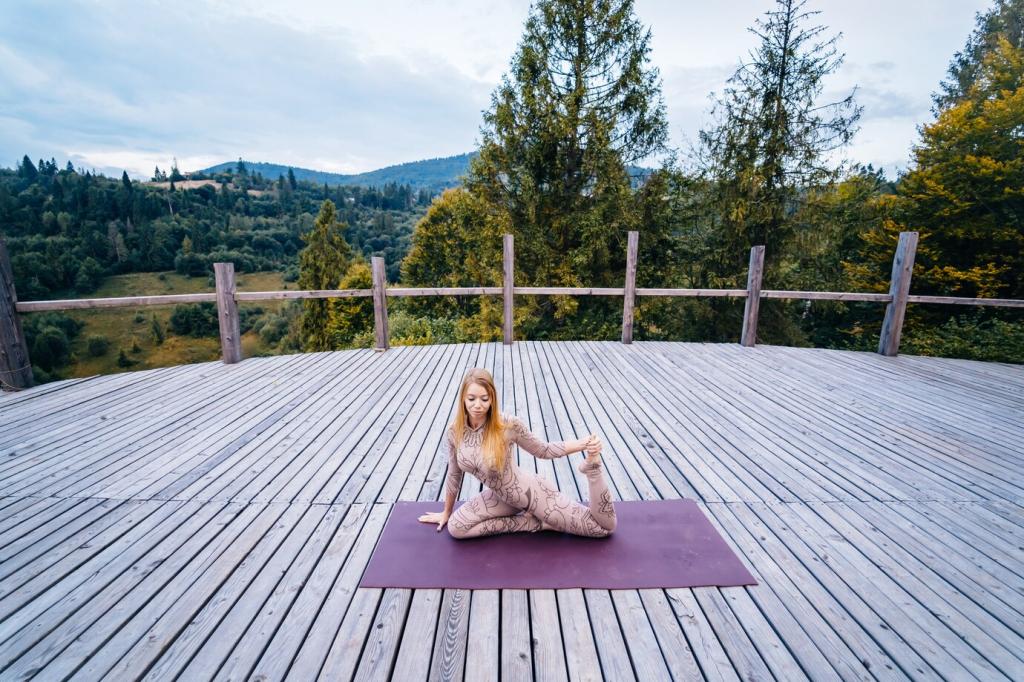
Silent Meditation Walks in the Wilderness
This edition explores the chosen theme: Silent Meditation Walks in the Wilderness. Step into quiet trails, soften your breath, and discover how stillness under open skies can recalibrate your mind, deepen attention, and kindle a lasting relationship with the living world.
Setting an Intention That Guides, Not Controls
Choose a simple intention such as noticing your breath, greeting each tree, or listening for distant water. Keep it light enough to follow you without pressure. Share your intention with us, and subscribe for monthly prompts tailored to quiet walking.
What to Bring for Comfort and Clarity
Pack lightly: layers, water, a small notebook, and a respectful awareness of wildlife. Leave headphones behind. A single warm drink can transform a chilly pause. Tell us your favorite minimalist item, and we’ll feature reader tips in future walks.
Choosing a Trail That Amplifies Silence
Look for gentle elevation, natural sound buffers like pines or dunes, and off-peak hours. Dawn often hushes human noise while awakening birdsong. Comment with your quietest local trail, and join our newsletter to receive a growing map of silent routes.

Mindful Techniques for the Trail
Footstep Counting and Whisper-Breath
Synchronize breath with steps—perhaps four counts in, four out. Let your feet become metronomes for attention. If thoughts gather, smile at them and return gently to rhythm. Share your preferred cadence so others can experiment on their next walk.
Five-Sense Scanning Without Labels
Rotate through hearing, sight, smell, touch, and taste, but resist naming. Let textures and tones arrive as raw experience. Afterward, journal one vivid sensation and send us a line; your observation might inspire someone’s next silent morning.
Micro-Pauses at Landmarks
At a mossed stump or sunlit bend, pause and notice the shift in your body’s tone. Micro-pauses reset wandering attention. Tag us with a photo of your landmark (no people, just place), and subscribe for our seasonal landmark meditation guides.

The Science of Quiet and Green Spaces
Attention Restoration in Practice
Research on attention restoration suggests gentle, fascinating stimuli—like drifting leaves—replenish mental focus. A 20-minute quiet walk can reduce mental fatigue. Try it this week, then tell us how your concentration shifted during work or study afterward.
Breath, Heart, and the Parasympathetic Response
Slow, steady breathing in natural settings nudges the parasympathetic system, softening heart rate and muscle tension. Notice if shoulders drop or jaw loosens. Share your post-walk body cues so we can compile a community map of common release points.
Soundscapes That Calm the Brain
Birdsong and water murmurs often sit within frequencies that the brain reads as safe. Aim for places where human engines fade. If you discover a naturally quiet cove or grove, send us a note—we’ll spotlight serene soundscapes in upcoming posts.
Stories from the Quiet Trail
A Foggy Ridge and a Forgotten To-Do List
On a damp ridge walk, a reader noticed fog threading through firs and realized their list had dissolved into breath. The tasks returned later, but lighter. Share your own dissolving moment; we’ll weave selected stories into a guided reflection series.
The River Bend That Taught Patience
Another walker paused at a bend where the river slowed to glass. They realized progress can be gentle yet unstoppable. If a place taught you patience, email us its name and a sentence—we’ll craft a communal gratitude map for quiet sites.
When Silence Became a Companion
One hiker feared silence would feel lonely. By the third outing, the hush felt like a kind friend. If you’re hesitant, start with ten minutes. Tell us how the first minutes felt; your note could encourage a newcomer to try.

Wilderness Etiquette and Safety in Silence
Stay on durable surfaces, carry out everything, and step lightly around fragile life. Silence is generous when we are. Pledge your Leave No Trace commitment by subscribing, and receive a printable checklist designed for silent walkers.
Wilderness Etiquette and Safety in Silence
If birds alarm or mammals pause, you’re too close. Increase distance without eye contact. Silence should soothe habitats, not stress them. Share your respectful wildlife encounters to help educate our community about coexisting gracefully on the trail.
Integrating Silence After the Walk
Write three sentences capturing pure sensations—temperature on skin, the grain of bark, a particular birdsong. Sensory journaling deepens memory pathways. Share one sentence with us, and we may feature it (with permission) in our monthly reflection roundup.
Integrating Silence After the Walk
Choose consistent windows—perhaps sunrise on Wednesdays. Routine reduces decision fatigue and invites depth. Subscribe for our seasonal calendars, which match ideal times with migrating birds, blooming cycles, and tide charts for coastal silent strolls.


